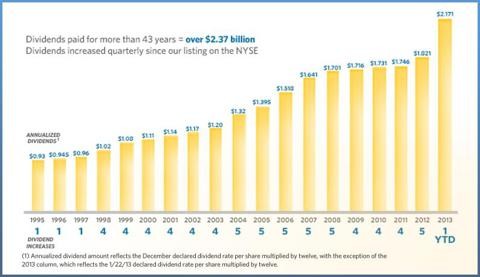Why Portfolio Manager Andrew Duffy Prefers REIT Mutual Funds To ETFs
Post on: 16 Март, 2015 No Comment

Recently, I had an opportunity to interview Andrew Duffy, senior portfolio manager of the James Alpha Global Real Estate Investment Fund (JAREX), to get his thoughts on the current market and outlook for global REITs and the benefits of investing via mutual funds.
Brad Thomas. What is the primary advantage of investing in a REIT mutual fund versus a REIT exchange-traded fund?
ETFs typically own 100% of the constituents of a market index, i.e. “the good, the bad and the ugly.” Conversely, mutual funds seek, through careful analysis and diligent research, to own only the good companies. Why would you want to own the bad and the ugly companies when you can invest via a mutual fund that seeks to own only the good ones?
This qualitative assertion is backed up by empirical evidence specific to global REITs: Over the past 10 years (2002 through 2011), the top-performing quartile of REITs each year outperformed the bottom-performing quartile by an average of 65%. The inescapable conclusion: not all REITs are created equal, and stock selection is key to maximizing returns on your portfolio.
Thomas. The James Alpha Global Real Estate Investments Fund is broadly diversified by geography, with the U.S. currently representing just around 50% of the portfolio. What drives the global diversity?
To qualify as a global fund, the SEC requires a minimum of 40% of the fund’s assets to be invested outside the U.S. The global REIT market is weighted approximately 35% to the U.S. Thus, the fund’s U.S. exposure will typically vary between 40% and 60%, depending on our assessment of the relative risk-adjusted returns available country-by-country around the world. Global diversity allows us to invest in countries with higher GDP growth rates, better demographics and other factors which can lead to higher returns, even on a risk-adjusted basis.
Thomas : A further question on diversification. How important is it to spread risk across multiple property types?
Property types differ in how they perform under different economic growth scenarios. The two primary criteria that we use to assess how each property type is expected to perform in a given growth scenario are: 1) how secular vs. cyclical are the demand drivers; and, 2) how short or long are the lease terms (similar to a bond’s duration).
Property types with cyclical demand and shorter lease terms (e.g. hotels) tend to perform better in times of strong economic growth, while property types with secular demand and longer lease terms (e.g. health care facilities) tend to perform better in times of weaker economic growth. Having the optimal mix of property types is another way we seek to generate alpha in the fund’s portfolio.
Thomas : How has the James Alpha Global Real Estate Investments Funds performed compared with other peer funds, as well as the global REIT market?
Since its inception over three years ago, the fund has delivered an annualized total return of about 14.5%, significantly above the 12.4% annual return of the FTSE EPRA/NAREIT Global REIT Index over the same time period. The fund has been awarded the 4 Star rating by Morningstar. and ranks in the 16 th percentile of its global real estate category.
Thomas : What is your edge in enhancing income?
Today’s historically-low interest rates leave many investors hungry for yield. To meet that need for our investors, we employ two income-enhancing strategies to boost portfolio income and deliver an above-market distribution yield (about 7% on current NAV, based on the last four quarterly distributions).
The two strategies are: 1) covered call-writing, and 2) dividend captures. Because they’re complementary in nature, we have a way to generate additional income regardless of market conditions: covered calls tend to work better in flat or down markets, where there’s less risk of a stock’s price running above the call’s strike price and being forced to sell the shares and forego further upside. Dividend captures, on the other hand, tend to work better in rising markets, where behavioral finance can result in a stock’s price recovering the ex-dividend amount quicker, sometimes within a few days.

Both strategies require careful evaluation and judicious application, calling on an understanding of both the art and the science that we’ve developed over more than 20 years of experience investing in global REITs.
Thomas : As you know, many of the strongest global REITs have repaired their balance sheets and restored their ability to play offense. What trends do you see today and how can investors benefit from the “survival of the fittest” strategies?
Commercial real estate is a capital-intensive business. The global financial crisis and ensuing economic challenges have weighed on the weaker companies with less access to (and higher cost) of capital, leading to a bifurcation of the industry into two camps: the “haves” and the “have nots” (meaning access to capital). Weaker companies with maturing debt on over-levered assets will be forced to either sell the properties, or hand the keys over to the lender who will in turn sell the properties. The high-quality REITs with strong balance sheets and access to plenty of low-cost capital are positioned to capitalize on the sales of good assets by weak borrowers, thus fueling their growth. In short, you’re either going to have a seat at the table, or you’re going to be on the menu. We seek to own in our fund the blue-chip REITs with strong balance sheets and seats at the table.
Thomas : Given the U.S. Fed’s commitment to low interest rates through at least mid-2015, along with easier monetary policy by other central banks, what tailwinds do you see this providing for global REITs today?
Low interest rates help commercial real estate and, by extension, REITs in three key ways:
1) Lower interest expense, which for most REITs is the largest expense item on their P&L, so low rates holds down interest expense, thus keeping profits up;
2) Lower capitalization rates, which are the inverse of a property’s cash flow multiple, thus lower cap rates mean higher valuations; and,
3) More appeal to yield-oriented investors who’ve grown increasingly dissatisfied with the meager yields available on bonds and instead buy REITs for their higher yields.














